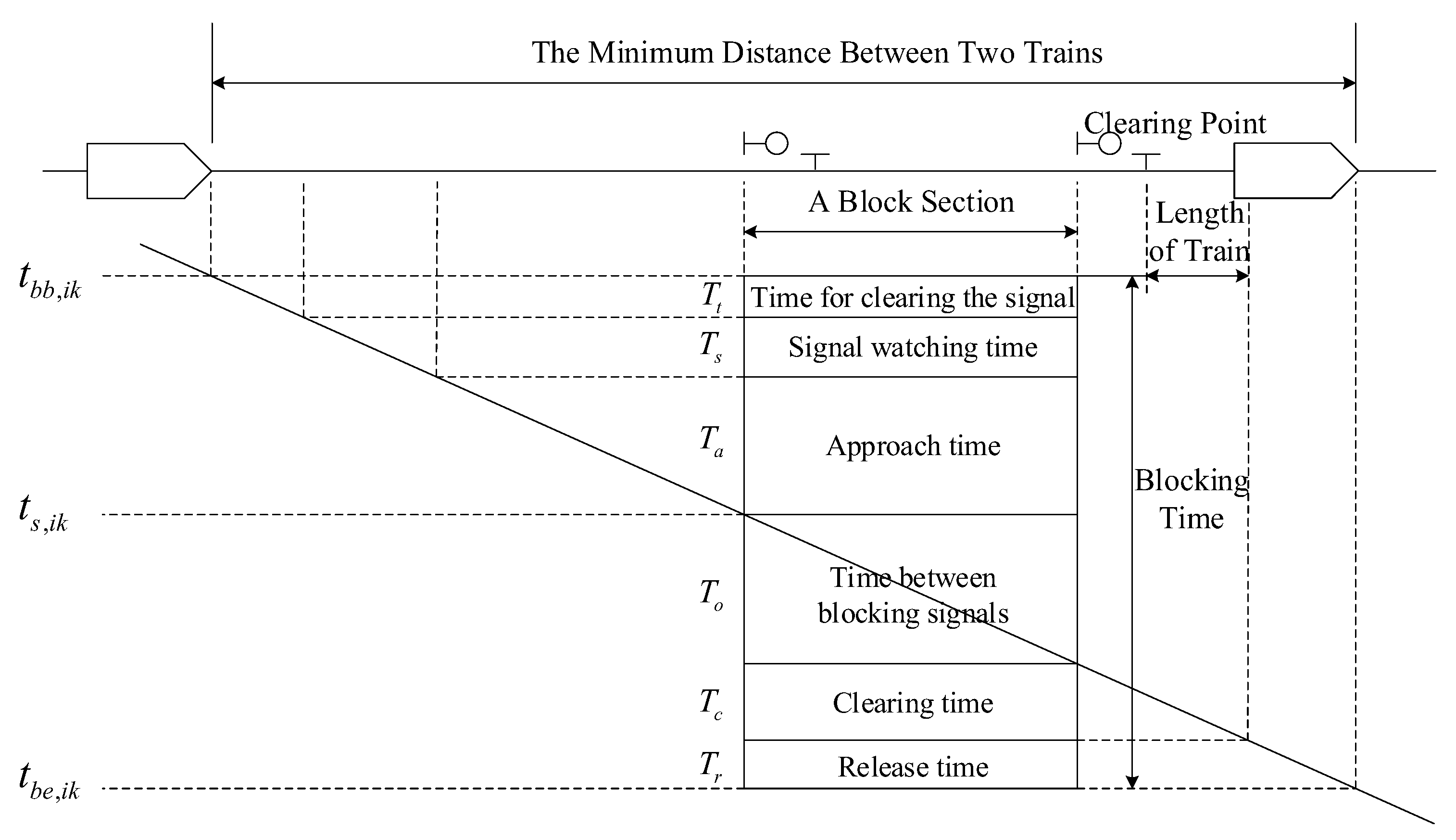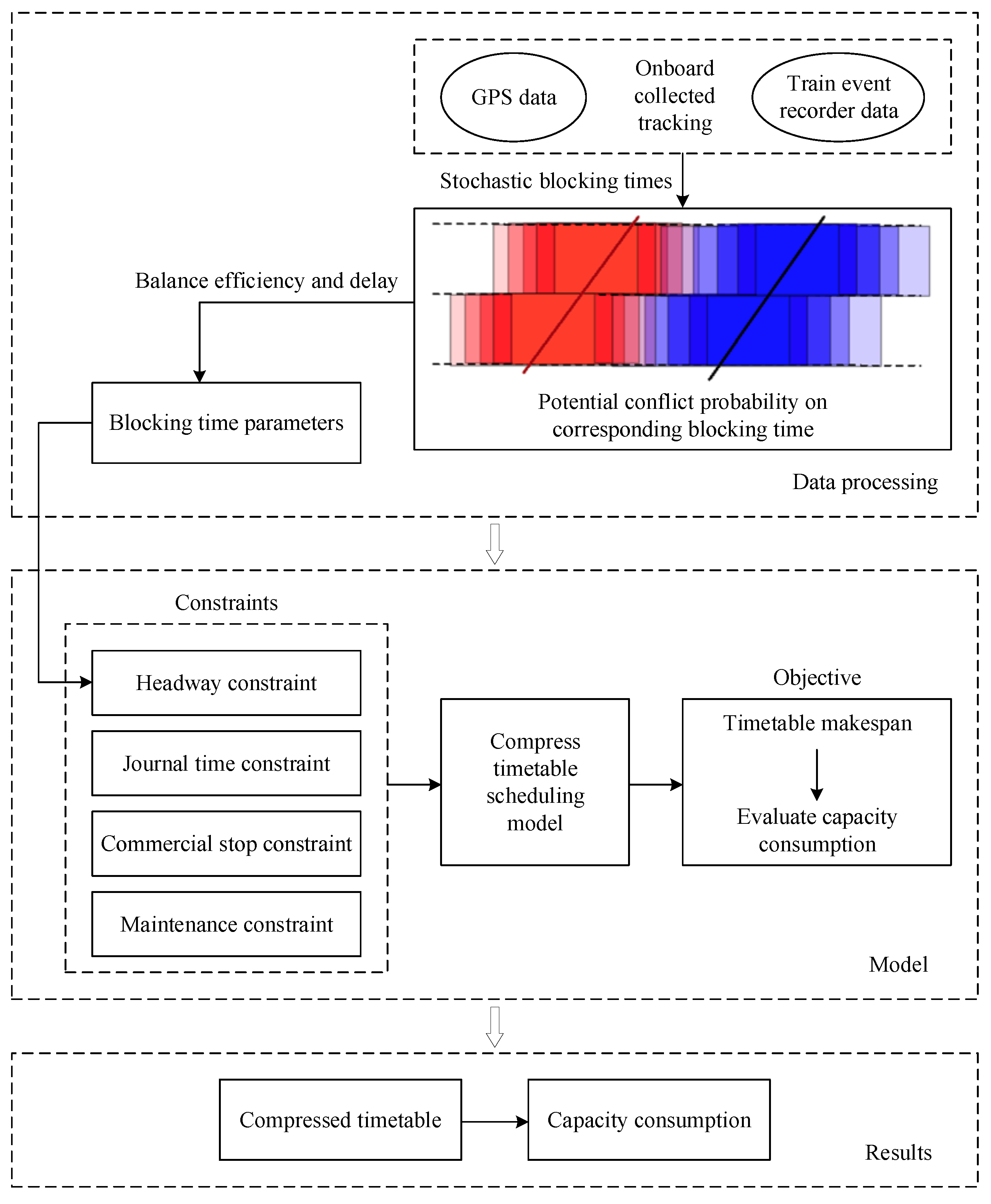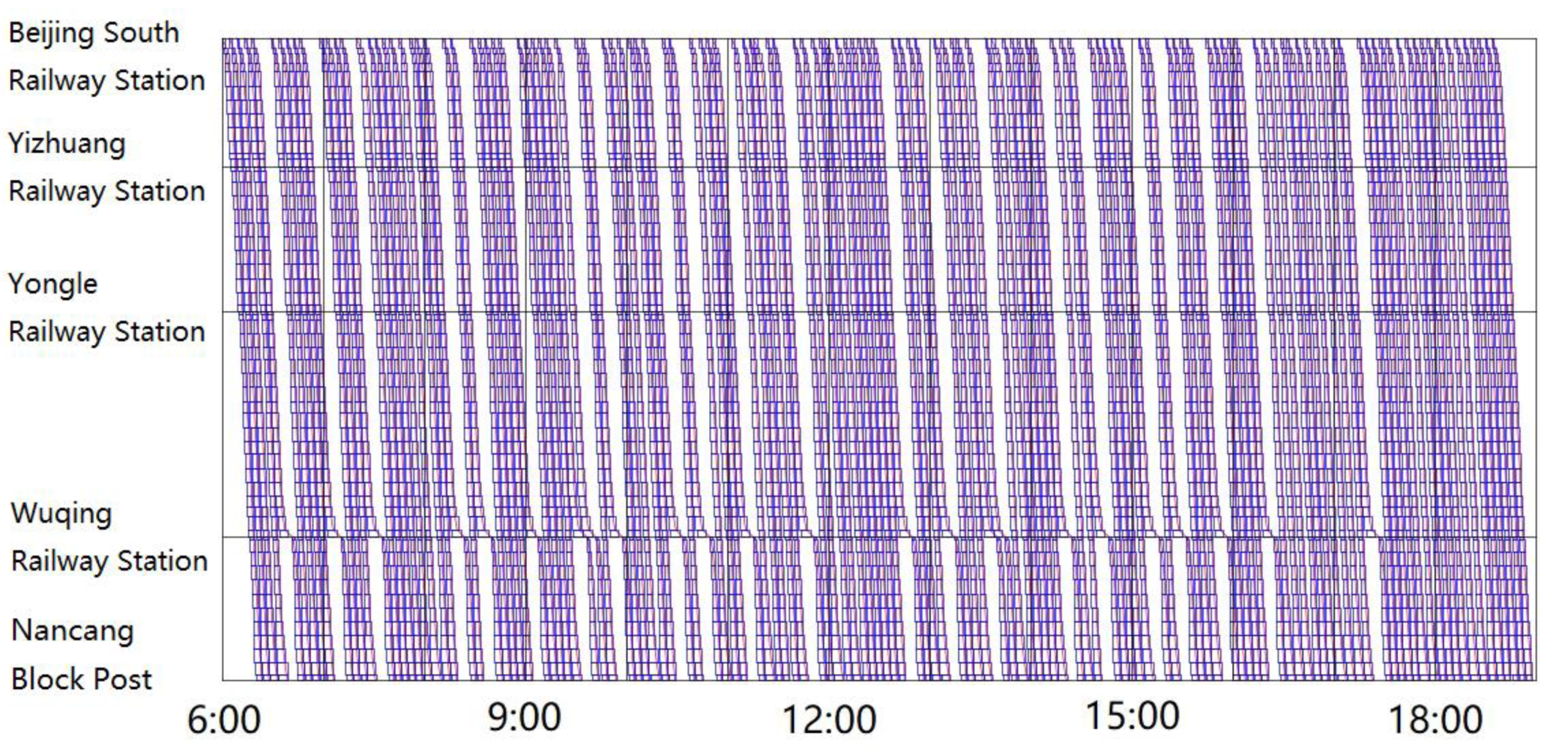Evaluating Line Capacity with an Analytical UIC Code 406 Compression Method and Blocking Time Stairway
Abstract
1. Introduction
2. Literature Review
3. Mathematical Formulas
3.1. Model
3.2. Blocking Time Parameters
4. Solution
5. Case Study
5.1. Background
5.2. Results
6. Conclusions
Author Contributions
Funding
Acknowledgments
Conflicts of Interest
References
- Lai, Y.C.; Wang, S.H.; Jong, J.C. Development of Analytical Capacity Models for Conventional Railways with Advanced Signaling Systems. J. Transp. Eng. 2012, 138, 961–974. [Google Scholar] [CrossRef]
- Heydar, M.; Petering, M.E.H.; Bergmann, D.R. Mixed integer programming for minimizing the period of a cyclic railway timetable for a single track with two train types. Comput. Ind. Eng. 2013, 66, 171–185. [Google Scholar] [CrossRef]
- Petering, M.E.H.; Heydar, M.; Bergmann, D.R. Mixed-integer programming for railway capacity analysis and cyclic, combined train timetabling and platforming. Transp. Sci. 2016, 50, 892–909. [Google Scholar] [CrossRef]
- Abril, M.; Barber, F.; Ingolotti, L.; Salido, M.A.; Tormos, P.; Lova, A. An assessment of railway capacity. Transp. Res. Part E Logist. Transp. Rev. 2008, 44, 774–806. [Google Scholar] [CrossRef]
- UIC. UIC Code 406: Capacity; International Union of Railways: Paris, France, 2004. [Google Scholar]
- Jamili, A. Computation of practical capacity in single-track railway lines based on computing the minimum buffer times. J. Rail Transp. Plan. Manag. 2018, 8, 91–102. [Google Scholar] [CrossRef]
- Goverde, R.M.P.; Corman, F.; D’Ariano, A. Railway line capacity consumption of different railway signalling systems under scheduled and disturbed conditions. J. Rail Transp. Plan. Manag. 2013, 3, 78–94. [Google Scholar] [CrossRef]
- Chu, F.; Oetting, A. Modeling capacity consumption considering disruption program characteristics and the transition phase to steady operations during disruptions. J. Rail Transp. Plan. Manag. 2013, 3, 54–67. [Google Scholar] [CrossRef]
- Zhang, X.; Nie, L. Integrating capacity analysis with high-speed railway timetabling: A minimum cycle time calculation model with flexible overtaking constraints and intelligent enumeration. Transp. Res. Part C Emerg. Technol. 2016, 68, 509–531. [Google Scholar] [CrossRef]
- Li, F.; Gao, Z.; Wang, D.Z.W.; Liu, R.; Tang, T.; Wu, J.; Yang, L. A subjective capacity evaluation model for single-track railway system with δ-balanced traffic and λ-tolerance level. Transp. Res. Part B Methodol. 2017, 105, 43–66. [Google Scholar] [CrossRef]
- Dicembre, A.; Ricci, S. Railway traffic on high density urban corridors: Capacity, signalling and timetable. J. Rail Transp. Plan. Manag. 2011, 1, 59–68. [Google Scholar] [CrossRef]
- Lai, Y.C.; Ip, C.S. An integrated framework for assessing service efficiency and stability of rail transit systems. Transp. Res. Part C Emerg. Technol. 2017, 79, 18–41. [Google Scholar] [CrossRef]
- Yan, F.; Goverde, R.M.P. Combined line planning and train timetabling for strongly heterogeneous railway lines with direct connections. Transp. Res. Part B Methodol. 2019, 127, 20–46. [Google Scholar] [CrossRef]
- Corriere, F.; Di Vincenzo, D.; Guerrieri, M. A logic fuzzy model for evaluation of the railway station’s practice capacity in safety operating conditions. Arch. Civ. Eng. 2013, 59, 3–19. [Google Scholar] [CrossRef]
- Armstrong, J.; Preston, J. Capacity utilisation and performance at railway stations. J. Rail Transp. Plan. Manag. 2017, 7, 187–205. [Google Scholar] [CrossRef]
- Chen, L.; Li, X.; Liu, G. Analysis of the capacity of the turning-back station in the railway system. In Proceedings of the ICTE 2013, Chengdu, China, 19–20 October 2013; pp. 2761–2765. [Google Scholar]
- Lindner, T. Applicability of the analytical UIC Code 406 compression method for evaluating line and station capacity. J. Rail Transp. Plan. Manag. 2011, 1, 49–57. [Google Scholar] [CrossRef]
- Pachl, J. Railway Operation and Control; VTD Rail Publishing: Mountlake Terrace, DC, USA, 2018. [Google Scholar]
- Liu, P.; Han, B. Optimizing the train timetable with consideration of different kinds of headway time. J. Algorithms Comput. Technol. 2017, 11, 148–162. [Google Scholar] [CrossRef]
- Tian, C.H.; Zhang, S.S.; Zhang, Y.S.; Jiang, X.L. Study on the Train Headway on Automatic Block Sections of High Speed Railway. J. China Railw. Soc. 2015, 37, 1–6. [Google Scholar]
- Wang, D.T. Optimization and Simulation Research of High-Speed Railway Train Tracking Interval. Ph.D. Thesis, Southwest Jiaotong University, Chengdu, China, 2016. [Google Scholar]
- Wu, L.; Gao, J.Q.; Mu, J.C. Model and calculation for tracking interval control of high-speed passenger trains. Jisuanji Yingyong. J. Comput. Appl. 2007, 27, 2643–2645. [Google Scholar]
- Chen, C. Study on train headways under CTCS-3 Train Operation Control System. Sci. Tech. Inf. Gansu. 2012, 41, 23–24. [Google Scholar]
- Sangphong, O.; Siridhara, S.; Ratanavaraha, V. Determining critical rail line blocks and minimum train headways for equal and unequal block lengths and various train speed scenarios. Eng. J. 2017, 21, 281–293. [Google Scholar] [CrossRef][Green Version]
- Medeossi, G.; Longo, G.; de Fabris, S. A method for using stochastic blocking times to improve timetable planning. J. Rail Transp. Plan. Manag. 2011, 1, 1–13. [Google Scholar] [CrossRef]
- Lai, Y.C.; Liu, Y.H.; Lin, Y.J. Standardization of capacity unit for headway-based rail capacity analysis. Transp. Res. Part C Emerg. Technol. 2015, 57, 68–84. [Google Scholar] [CrossRef]
- Xu, L.; Zhao, X.; Tao, Y.; Zhang, Q.; Liu, X. Optimization of train headway in moving block based on a particle swarm optimization algorithm. In Proceedings of the 2014 13th International Conference on Control Automation Robotics & Vision (ICARCV), Singapore, 10–12 December 2014; pp. 931–935. [Google Scholar]
- Liu, M.; Miao, J.R. Study on tracking headway of moving block based on blocking time. Shandong Sci. 2018, 31, 55–61. [Google Scholar]
- Lu, Q.Z. Investigation of Trains in Moving Block System Crossing a River Based on UIC406. Urban Rapid Rail Transit. 2018, 31, 140–144. [Google Scholar]









| Publication | Model Structure | Objective | Headway | Problem Size |
|---|---|---|---|---|
| A. Jamili [6] | UIC Code 406 compression method | Minimize consumption time | Minimum required headway applied by the signaling system | 6 stations, 9 trains, 7 sections |
| Rob M.P. Goverde [7] | UIC Code 406 compression method | Minimize cycle time | The minimum headway time depends on the critical block section | 6 stations, 10 trains in one cycle |
| Friederike Chu [8] | UIC Code 406 compression method | Higher occupancy rate in one cycle | The minimum headway time is 2.5 minutes | 20 trains per hour |
| Mojtaba Heydar [2] | Mixed-integer linear programming model | Minimize the cycle lengthand the total dwell time of trains at all stations | The minimum headway time is a certain value varying from 1 to 5 minutes | 10–70 stations, 3–64 trains |
| Matthew E. H. Petering [3] | Mixed-integer linear programming model | Minimize the cycle length and the total journey time of all trains | Headways are different certain values in different examples | 5–35 intermediate stations, 3–11 train types |
| Xin Zhang [9] | Integer programming model | Minimize the cycle time | 7 types of headways with certain values | 23 stations, 18 trains in one cycle |
| Feng Li et al. [10] | Mixed-integer programming model | Maximize the number of train-pairs and Minimize the total travel times of all trains | Consist of 4 types of headways with certain values | 5 stations, 4 train-pairs, 4 segments |
| A. Dicembre et al. [11] | A methodology for capacity quantification | Maximize the number of trains | The adopted headway depending upon the adopted signaling system, such as minimum headway of 3 min during rush hours in Milan | 10 stations |
| Yung-Cheng Lai et al. [12] | A comprehensive evaluation framework of capacity | Maximize capacity utilization and minimize expected recovery time | Headway is a certain value, such as 2.5 min on 07:00–09:00 weekday and 5 min on 06:00–23:00 weekend | 24 stations |
| Fei Yan [13] | Mixed-integer linear programming model | Minimize travel time, empty-seat-hour and the number of lines | The minimum headway time is 3 minutes | 14 stations, 25 trains in one cycle |
| Ruxin Wang et al. (this paper) | Linear programming model | Minimize makespan of timetable | Based on a large number of real train operations data, the minimum headway is calculated by using blocking time stairway | 5 stations, 131 trains, 56 sections |
| Notation | Description |
|---|---|
| Distance traveled by a train during additional time of interval tracking operation | |
| Braking distance | |
| Safety protection distance | |
| Length of the block section | |
| Length of the train | |
| Train interval tracking distance between sections | |
| Distance between train stop sign and departure signal | |
| Distance traveled by a train during station operation time | |
| Train interval tracking distance when departing from a station | |
| Length of throat area of station | |
| Train interval tracking distance when arriving in a station | |
| Train interval tracking distance when passing a station |
| Notation | Description |
|---|---|
| Number of trains | |
| Number of block sections | |
| Set of trains, | |
| Set of stopped trains, | |
| Set of block sections, | |
| Set of block sections of stations, | |
| Train index, | |
| Block section index, | |
| Journey time for train in block section | |
| Dwell time for train in block section | |
| The time when train passes the blocking signal of block section (the arrival time of the train at the block section is set to 0) | |
| The beginning time when block section begins to lock for the occupation of train (the arrival time of the train at the block section is set to 0) | |
| The ending time when block section ends to lock for the occupation of train (the arrival time of the train at the block section is set to 0) | |
| The beginning time of maintenance | |
| The ending time of maintenance |
| Variable | Description |
|---|---|
| The arrival time for train arriving at block section | |
| The departure time for train leaving block section |
| Constraint | Graphical Representation |
|---|---|
| Journey time constraint |  |
| Headway constraint |  where is the time interval between the two blocking time blocks after the delay of the latter train line and the value of should be greater than or equal to 0 |
| Commercial stop constraint |  |
| Maintenance constrain |  |
| Each Part of the Blocking Time | Values (in Seconds) |
|---|---|
| Time for clearing the signal | 5 |
| Signal watching time | 3 |
| Approach time | |
| Time between blocking signals | |
| Clearing time | |
| Release time | 5 |
| Data Name | Value |
|---|---|
| The earliest departure time | 6:02:00 |
| The latest arrival time | 0:29:15 |
| Occupation time on sections | 1107.25 min |
| The average train headway | 8.34 min |
| The average journey time | 25.46 min |
| Indicator | Result of the Refined Model | Result of the Existing Method |
|---|---|---|
| The earliest departure time | 6:00:00 | 6:00:00 |
| The latest arrival time | 18:57:20 | 20:02:45 |
| Occupation time on sections | 777.33 min | 842.75 min |
| The average train headway | 5.78 min | 6.29 min |
| Indicator | Result of Seven Block Sections | Result of Three Block Sections |
|---|---|---|
| The earliest departure time | 6:00:00 | 6:00:00 |
| The latest arrival time | 18:57:20 | 15:12:51 |
| Occupation time on sections | 777.33 min | 552.85 min |
| The average train headway | 5.78 min | 4.06 min |
| Indicator | Result of 350 km/h | Result of 300 km/h |
|---|---|---|
| The earliest departure time | 6:00:00 | 6:00:00 |
| The latest arrival time | 18:57:25 | 20:54:50 |
| Occupation time on sections | 775.41 min | 894.83 min |
| The average train headway | 5.77 min | 6.66 min |
© 2020 by the authors. Licensee MDPI, Basel, Switzerland. This article is an open access article distributed under the terms and conditions of the Creative Commons Attribution (CC BY) license (http://creativecommons.org/licenses/by/4.0/).
Share and Cite
Wang, R.; Nie, L.; Tan, Y. Evaluating Line Capacity with an Analytical UIC Code 406 Compression Method and Blocking Time Stairway. Energies 2020, 13, 1853. https://doi.org/10.3390/en13071853
Wang R, Nie L, Tan Y. Evaluating Line Capacity with an Analytical UIC Code 406 Compression Method and Blocking Time Stairway. Energies. 2020; 13(7):1853. https://doi.org/10.3390/en13071853
Chicago/Turabian StyleWang, Ruxin, Lei Nie, and Yuyan Tan. 2020. "Evaluating Line Capacity with an Analytical UIC Code 406 Compression Method and Blocking Time Stairway" Energies 13, no. 7: 1853. https://doi.org/10.3390/en13071853
APA StyleWang, R., Nie, L., & Tan, Y. (2020). Evaluating Line Capacity with an Analytical UIC Code 406 Compression Method and Blocking Time Stairway. Energies, 13(7), 1853. https://doi.org/10.3390/en13071853





